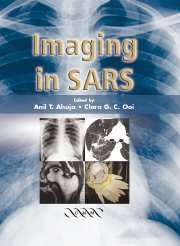Book contents
- Frontmatter
- Contents
- Contributors
- Preface
- 1 The Epidemiology of Severe Acute Respiratory Syndrome: A Global Perspective
- 2 The Role of Emergency Medicine in Screening SARS Patients
- 3 Severe Acute Respiratory Syndrome Outbreak in a University Hospital in Hong Kong
- 4 Imaging of Pneumonias
- 5 The Role of Chest Radiographs in the Diagnosis of SARS
- 6 Chest Radiography: Clinical Correlation and Its Role in the Management of Severe Acute Respiratory Syndrome
- 7 The Role of High-Resolution Computed Tomography in Diagnosis of SARS
- 8 The Role of Imaging in the Follow-up of SARS
- 9 Treatment of Severe Acute Respiratory Syndrome
- 10 SARS in the Intensive Care Unit
- 11 Imaging of Pneumonia in Children
- 12 Imaging and Clinical Management of Paediatric SARS
- 13 Imaging of SARS in North America
- 14 Radiographers' Perspective in the Outbreak of SARS
- 15 Implementation of Measures to Prevent the Spread of SARS in a Radiology Department
- 16 Aftermath of SARS
- 17 Update on Severe Acute Respiratory Syndrome
- Index
5 - The Role of Chest Radiographs in the Diagnosis of SARS
Published online by Cambridge University Press: 27 October 2009
- Frontmatter
- Contents
- Contributors
- Preface
- 1 The Epidemiology of Severe Acute Respiratory Syndrome: A Global Perspective
- 2 The Role of Emergency Medicine in Screening SARS Patients
- 3 Severe Acute Respiratory Syndrome Outbreak in a University Hospital in Hong Kong
- 4 Imaging of Pneumonias
- 5 The Role of Chest Radiographs in the Diagnosis of SARS
- 6 Chest Radiography: Clinical Correlation and Its Role in the Management of Severe Acute Respiratory Syndrome
- 7 The Role of High-Resolution Computed Tomography in Diagnosis of SARS
- 8 The Role of Imaging in the Follow-up of SARS
- 9 Treatment of Severe Acute Respiratory Syndrome
- 10 SARS in the Intensive Care Unit
- 11 Imaging of Pneumonia in Children
- 12 Imaging and Clinical Management of Paediatric SARS
- 13 Imaging of SARS in North America
- 14 Radiographers' Perspective in the Outbreak of SARS
- 15 Implementation of Measures to Prevent the Spread of SARS in a Radiology Department
- 16 Aftermath of SARS
- 17 Update on Severe Acute Respiratory Syndrome
- Index
Summary
Introduction
At the onset of the severe acute respiratory syndrome (SARS) crisis, the majority of patients were presented with respiratory symptoms. As the epidemic progressed, either due to a different mode of transmission or a mutation of the virus, some SARS patients presented with minor or no respiratory symptoms but diarrhoea. Understandably, this created a problem with case definition and diagnosis, and the lack of a reliable and rapid biochemical test for SARS placed more emphasis on chest imaging findings for diagnosis of the disease.
The wide availability, speed and inexpensive nature of the chest radiograph (CXR) has made it the first-line imaging investigation when faced with a respiratory complaint. It is only fitting that the initial imaging investigation of SARS also starts here. This chapter presents the radiographic features of SARS and the differential diagnosis.
Pathological considerations
Viral infection of the respiratory tract may involve the upper system, from the common cold (rhinoviruses and coronaviruses), larynx (respiratory syncitial virus), trachea and bronchi (herpes simplex type 1) to the lung parenchyma (influenza). The initial phase in viral lung parenchymal involvement is called a pneumonitis. A local inflammatory response is directed towards the offending virus, an inflammatory cocktail of cells and fluid accumulate in the alveolar interstitium of the lung parenchyma. In bacterial infections this exudate spills over into the airspace and results in the classic consolidation.
- Type
- Chapter
- Information
- Imaging in SARS , pp. 53 - 60Publisher: Cambridge University PressPrint publication year: 2004

